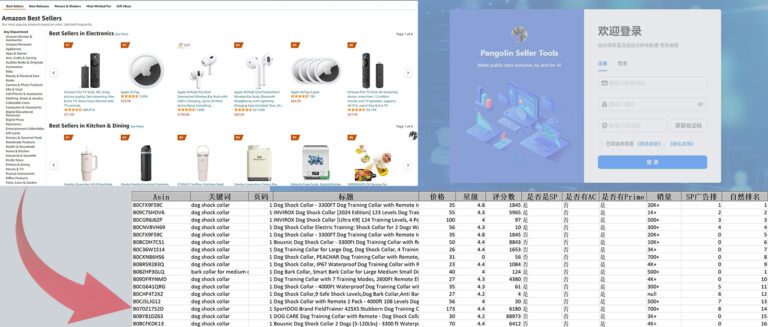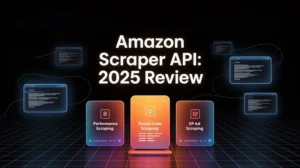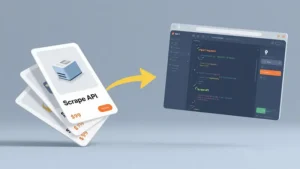Introduction
The Importance and Application of Amazon Best Sellers Data
Amazon Best Sellers data represents the most popular products in the market. For e-commerce analysts and market researchers, this data provides valuable insights. By analyzing best sellers data, one can understand current market trends, consumer preferences, and the characteristics of popular products.
The Role of Data Scraping in E-Commerce Analysis and Market Research
Data scraping is crucial in e-commerce analysis and market research. By collecting and analyzing data, businesses can monitor competitors’ actions, formulate product positioning and market strategies, and optimize inventory management and marketing strategies.
The Motivation and Goals of Using Python for Data Scraping
Python is the preferred language for data scraping due to its powerful libraries and simple syntax. Using Python, we can automate the process of scraping Amazon Best Sellers data for real-time analysis and decision support.
1. Why Scrape Amazon Best Sellers Data
Market Trend Analysis
By scraping Amazon Best Sellers data, we can identify trending products in the market and understand current consumer demands and preferences. This helps businesses adjust product strategies and predict market trends.
Competitor Monitoring
Monitoring competitors’ best-selling products and sales strategies helps businesses find opportunities and threats in the market and adjust their own marketing and sales strategies in time.
Product Positioning and Market Strategy Formulation
By analyzing best-selling product data, businesses can better position their own products and formulate more targeted market strategies to enhance market competitiveness.
2. Challenges in Scraping Amazon Best Sellers Data
Technical Challenges of Dynamic Content Loading
Amazon Best Sellers pages often use dynamic loading techniques, where data is not embedded directly in the HTML but loaded dynamically via JavaScript, posing a challenge for data scraping.
Circumventing Anti-Scraping Mechanisms
Amazon’s website has complex anti-scraping mechanisms, including IP bans and CAPTCHA verification. Effectively circumventing these mechanisms is a key issue in the data scraping process.
Ensuring Data Timeliness and Accuracy
To ensure data timeliness and accuracy, scrapers need to handle frequent data updates and changes while ensuring the stability and completeness of the scraped data.
3. Environment Setup and Tool Selection
Setting Up Python Environment
First, we need to set up the Python environment. It’s recommended to use Anaconda to manage the Python environment and dependencies, facilitating subsequent development and maintenance.
Installing Necessary Libraries: Selenium, Webdriver Manager, pandas, etc.
After setting up the Python environment, install the necessary libraries:
pip install selenium webdriver-manager pandas
- Selenium: Used for automating browser operations.
- Webdriver Manager: Simplifies the management of browser drivers.
- pandas: Used for data processing and analysis.
Development Tool Selection and Configuration
It is recommended to use VSCode or PyCharm as development tools. These tools offer powerful code editing and debugging features, improving development efficiency.
4. Web Scraping Basics: Understanding Amazon Website Structure
Analyzing Amazon Best Sellers Page
First, analyze the structure of the Amazon Best Sellers page to understand how data is loaded and the position of page elements. This can be done using the browser’s developer tools (F12).
Inspecting and Locating Page Elements
Using the developer tools, inspect the HTML structure of the page to find elements containing product information. These elements are usually marked by specific tags and attributes, such as product names in <span> tags and prices in <span class="price">.
5. Writing the Scraper Script
Initializing Webdriver
First, initialize the Webdriver:
from selenium import webdriver
from webdriver_manager.chrome import ChromeDriverManager
driver = webdriver.Chrome(ChromeDriverManager().install())
This code uses Webdriver Manager to automatically download and configure the Chrome driver.
Configuring and Launching the Browser
You can configure browser options, such as headless mode, to improve scraping efficiency:
options = webdriver.ChromeOptions()
options.add_argument('--headless')
driver = webdriver.Chrome(ChromeDriverManager().install(), options=options)
Navigating to the Target Page
Use Selenium to navigate to the Amazon Best Sellers page:
url = 'https://www.amazon.com/Best-Sellers/zgbs'
driver.get(url)
Using Selenium to Open Amazon Best Sellers Page
Ensure the page is fully loaded before scraping data:
import time
time.sleep(5) # Wait for the page to load completely
Parsing and Locating Elements
Use XPath or CSS selectors to locate product data:
products = driver.find_elements_by_xpath('//div[@class="zg-item-immersion"]')
6. Practical Data Scraping
Handling Dynamic Loading Content
For dynamically loaded content, use Selenium’s wait mechanism:
from selenium.webdriver.common.by import By
from selenium.webdriver.support.ui import WebDriverWait
from selenium.webdriver.support import expected_conditions as EC
wait = WebDriverWait(driver, 10)
products = wait.until(EC.presence_of_all_elements_located((By.XPATH, '//div[@class="zg-item-immersion"]')))
Scraping Product Information
Iterate through the product list and extract names, prices, ratings, and sales data:
data = []
for product in products:
name = product.find_element_by_xpath('.//span[@class="p13n-sc-truncated"]').text
price = product.find_element_by_xpath('.//span[@class="p13n-sc-price"]').text
rating = product.find_element_by_xpath('.//span[@class="a-icon-alt"]').text
data.append({'name': name, 'price': price, 'rating': rating})
Handling Pagination and Infinite Scrolling
For pagination and infinite scrolling, write code to automate page flipping and scrolling:
while True:
try:
next_button = driver.find_element_by_xpath('//li[@class="a-last"]/a')
next_button.click()
time.sleep(5) # Wait for the new page to load
products = driver.find_elements_by_xpath('//div[@class="zg-item-immersion"]')
except:
break # No more pages, exit the loop
7. Data Storage and Processing
Using pandas to Process and Store Scraped Data
Convert the scraped data to a DataFrame and save it as a CSV file:
import pandas as pd
df = pd.DataFrame(data)
df.to_csv('amazon_best_sellers.csv', index=False)
Data Cleaning and Formatting
Clean and format the data for subsequent analysis:
df['price'] = df['price'].str.replace('$', '').astype(float)
df['rating'] = df['rating'].str.extract(r'(\d+\.\d+)').astype(float)
8. Precautions and Common Issues
Complying with the robots.txt Protocol
Before scraping data, check the target website’s robots.txt file to ensure that the scraping behavior complies with the site’s regulations.
Simulating Normal User Behavior to Avoid Detection
Simulate normal user behavior by adding random delays and switching User-Agent to reduce the risk of detection:
import random
time.sleep(random.uniform(2, 5)) # Random delay
Handling Exceptions and Errors
Include exception handling mechanisms in the scraper script to improve robustness:
try:
# Scraper code
except Exception as e:
print(f'Error: {e}')
driver.quit()
9. Case Study
Demonstrating Scraper Deployment and Operation with a Specific Case
Below is a detailed case study showcasing a complete scraper script, running tests, and validating its functionality and performance.
Complete Scraper Script
import time
import random
import pandas as pd
from selenium import webdriver
from selenium.webdriver.common.by import By
from selenium.webdriver.support.ui import WebDriverWait
from selenium.webdriver.support import expected_conditions as EC
from webdriver_manager.chrome import ChromeDriverManager
# Initialize WebDriver
options = webdriver.ChromeOptions()
options.add_argument('--headless')
driver = webdriver.Chrome(ChromeDriverManager().install(), options=options)
# Navigate to Amazon Best Sellers page
url = 'https://www.amazon.com/Best-Sellers/zgbs'
driver.get(url)
time.sleep(5) # Wait for the page to load completely
# Scrape data
data = []
while True:
wait = WebDriverWait(driver, 10)
products = wait.until(EC.presence_of_all_elements_located((By.XPATH, '//div[@class="zg-item-immersion"]')))
for product in products:
try:
name = product.find_element_by_xpath('.//span[@class="p13n-sc-truncated"]').text
except:
name = None
try:
price = product.find_element_by_xpath('.//span[@class="p13n-sc-price"]').text
except:
price = None
try:
rating = product.find_element_by_xpath('.//span[@class="a-icon-alt"]').text
except:
rating = None
data.append({'name': name, 'price': price, 'rating': rating})
try:
next_button = driver.find_element_by_xpath('//li[@class="a-last"]/a')
next_button.click()
time.sleep(random.uniform(2, 5)) # Random delay
except:
break # No more pages, exit the loop
# Save data
df = pd.DataFrame(data)
df.to_csv('amazon_best_sellers.csv', index=False)
# Clean data
df['price'] = df['price'].str.replace('$', '').astype(float)
df['rating'] = df['rating'].str.extract(r'(\d+\.\d+)').astype(float)
Analyzing Key Code and Implementation Logic in the Case Study
- Initializing WebDriver and Configuring the Browser: This part of the code initializes WebDriver and configures headless mode to avoid the browser interface affecting performance.
- Navigating to the Target Page and Waiting for Load: The script navigates to the Amazon Best Sellers page using
driver.get(url)and usestime.sleepto wait for the page to fully load. - Scraping Data: Using a
while Trueloop, the script scrapes data from all pages, processing each product’s information and storing it in thedatalist. - Handling Pagination and Random Delays: Pagination is handled by locating and clicking the “Next” button, and random delays are introduced using
random.uniformto simulate normal user behavior. - Saving and Cleaning Data: The scraped data is saved as a CSV file and cleaned using pandas for easier subsequent analysis.
10. Current State and Challenges of Scraping Amazon Data
Common Practices and Effectiveness in Current Data Scraping
Currently, commonly used tools and methods for data scraping include Selenium, Scrapy, and BeautifulSoup. Each has its pros and cons: Selenium is suitable for scraping dynamically loaded pages, while Scrapy and BeautifulSoup are better for extracting data from static pages.
Main Difficulties and Challenges Faced
Key difficulties and challenges in data scraping include:
- Anti-Scraping Mechanisms: Many websites use complex anti-scraping mechanisms like IP bans and CAPTCHA verification, which require solutions like proxy pools and user behavior simulation to circumvent.
- Complex Data Structures: Some pages have complex and variable data structures, requiring flexible parsing code.
- Real-Time Requirements: To ensure data timeliness, scrapers need to run frequently and update data promptly.
11. A Better Alternative: Pangolin Scrape API
Introducing the Features and Advantages of Pangolin Scrape API
Pangolin Scrape API is an efficient data scraping solution that offers capabilities such as avoiding maintenance of scrapers, proxies, and bypassing CAPTCHA, making data scraping more convenient and stable.
No Need to Maintain Scrapers, Proxies, and Bypass CAPTCHA
Using Pangolin Scrape API eliminates the need to manually maintain scraper scripts and proxy pools, and handle complex CAPTCHA, significantly simplifying the data scraping process.
Real-Time Data Retrieval and Ability to Scrape by Specific ZIP Codes
Pangolin Scrape API provides real-time data retrieval and the ability to scrape data by specific ZIP codes, further improving the precision and usefulness of the data. For example, it allows for more granular market analysis by obtaining product data for specific regions.
12. Summary
Summarizing the Steps and Key Points of Implementing Python Scraper
This article provides a detailed overview of the steps and key points in using a Python scraper to scrape Amazon Best Sellers data, including environment setup, writing scraper scripts, handling dynamic content, scraping product information, and data storage and processing.
Emphasizing the Advantages of Pangolin Scrape API as an Alternative
While Python scrapers are powerful in data scraping, Pangolin Scrape API offers a more efficient and stable alternative, simplifying the workflow of data scraping.
Providing Further Learning and Exploration Resources
Recommended further learning and exploration resources include Python scraping tutorials, data analysis tools, etc.:







